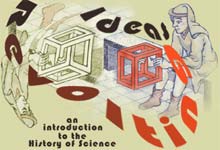
University of California, Irvine
Instructor: Dr. Barbara J. Becker

|
|
Developments in the Life Sciences |
|
| 1677 | Anton von Leeuwenhoek (1632-1723) observed "animalcules" under a microscope |
| 1694 | Homunculus drawn by Nicholas Hartsoeker (1656-1725) |
| 1784 | Lazzaro Spallanzani (1729-1799) artificially inseminated a dog which gave birth to 3 healthy pups 62 days later. |
| 1785 | child born following the first attempts at artificial insemination on a human subject by Scottish surgeon, John Hunter (1728-1793) |
| 1827 | Karl Ernst von Baer (1792-1876) identified the mammalian ovum; like many of his predecessors, he regarded sperm cells as parasites; named them "spermatozoa" |
| 1866 | American gynecologist, Marion Sims (1813-1883), performed 55 artificial inseminations on 6 women with cervical abnormalities; one pregnancy occurred |
| 1884 | William Pancoast of Philadelphia performed the first confirmed artificial insemination using donor sperm; while under anesthesia, the wife of one of Pancoast's patients was successfully impregnated before an audience of medical students using semen obtained from "the best-looking member of the class" |
| 1897 | British biologist Walter Heape (1855-1929) recovered rabbit embryo after flushing oviduct; transferred it to foster-mother, in which normal development continued; work encouraged others to look at possibility of culturing embryos in the laboratory |
|
DAEDALUS
A paper read to the Heretics, Cambridge, on February 4, 1923
...It is a fairly safe prophecy that in 50 years light will cost about a fiftieth of its present price, and there will be no more night in our cities. The alternation of day and night is a check on the freedom of human activity which must go the way of other spatial and temporal checks. In the long run I think that all that applied physics can do for us is abolish these checks. It enables us to possess more, travel more, and communicate more. I shall not attempt to predict in detail the future developments of transport and communication. They are only limited by the velocity of light. We are working towards a condition when any two persons on earth will be able to be completely present to one another in not more than 1/24 of a second. We shall never reach it, but that is the limit which we shall approach indefinitely. Developments in this direction are tending to bring mankind more and more together, to render life more and more complex, artificial, and rich in possibilities--to increase indefinitely man's powers for good and evil.... As for the supplies of mechanical power, it is axiomatic that the exhaustion of our coal and oil-fields is a matter of centuries only. As it has often been assumed that their exhaustion would lead to the collapse of industrial civilization, I may perhaps be pardoned if I give some of the reasons which lead me to doubt this proposition. Water-power is not, I think, a probable substitute, on account of its small quantity, seasonal fluctuation, and sporadic distribution. It may perhaps, however, shift the centre of industrial gravity to well-watered mountainous tracts such as the Himalayan foothills, British Columbia, and Armenia. Ultimately we shall have to tap those intermittent but inexhaustible sources of power, the wind and the sunlight. The problem is simply one of storing their energy in a form as convenient as coal or petrol. If a windmill in one's back garden could produce a hundredweight of coal daily (and it can produce its equivalent in energy), our coalmines would be shut down to-morrow. Even to-morrow a cheap, foolproof, and durable storage battery may be invented, which will enable us to transform the intermittent energy of the wind into continuous electric power. Personally, I think that four hundred years hence the power question in England may be solved somewhat as follows: The country will be covered with rows of metallic windmills working electric motors which in their turn supply current at a very high voltage to great electric mains. At suitable distances, there will be great power stations where during windy weather the surplus power will be used for the electrolytic decomposition of water into oxygen and hydrogen. These gasses will be liquefied, and stored in vast vacuum jacketed reservoirs, probably sunk in the ground. If these reservoirs are sufficiently large, the loss of liquid due to leakage inwards of heat will not be great; thus the proportion evaporating daily from a reservoir 100 yards square by 60 feet deep would not be 1/1000 of that lost from a tank measuring two feet each way. In times of calm, the gasses will be recombined in explosion motors working dynamos which produce electrical energy once more, or more probably in oxidation cells. Liquid hydrogen is weight for weight the most efficient known method of storing energy, as it gives about three times as much heat per pound as petrol. On the other hand it is very light, and bulk for bulk has only one third of the efficiency of petrol. This will not, however, detract from its use in aeroplanes, where weight is more important than bulk. These huge reservoirs of liquified gasses will enable wind energy to be stored, so that it can be expended for industry, transportation, heating and lighting, as desired. The initial costs will be very considerable, but the running expenses less than those of our present system. Among its more obvious advantages will be the fact that energy will be as cheap in one part of the country as another, so that industry will be greatly decentralized; and that no smoke or ash will be produced.... The chemical or physical inventor is always a Prometheus. There is no great invention, from fire to flying, which has not been hailed as an insult to some god. But if every physical and chemical invention is a blasphemy, every biological invention is a perversion. There is hardly one which, on first being brought to the notice of an observer from any nation which has not previously heard of their existence, would not appear to him as indecent and unnatural.... ...I am going to suggest a few obvious developments which seem probable in the present state of biological science, without assuming any great new generalizations of the type of Darwinism. I have the very best precedents for introducing a myth at this point, so perhaps I may be excused if I reproduce some extracts from an essay on the influence of biology on history during the 20th century which will (it is hoped) be read by a rather stupid undergraduate member of this university to his supervisor during his first term 150 years hence. "As early as the first decade of the twentieth century we find a conscious attempt at the application of biology to politics in the so-called eugenic movement. A number of earnest persons, having discovered the existence of biology, attempted to apply it in its then very crude condition to the production of a race of super-men, and in certain countries managed to carry a good deal of legislation. They appear to have managed to prevent the transmission of a good deal of syphilis, insanity, and the like, and they certainly succeeded in producing the most violent opposition and hatred amongst the classes whom they somewhat gratuitously regarded as undesirable parents. (There was even a rebellion in Nebraska). However, they undoubtably prepared public opinion for what was to come, and so far served a useful purpose. Far more important was the progress in medicine which practically abolished infectious diseases in those countries which were prepared to tolerate the requisite amount of state interference in private life, and finally, after the [League of Nations'] ordinance of 1958, all over the world; though owing to Hindu opposition, parts of India were still quite unhealthy up to 1980 or so.Our essayist would then perhaps go on to discuss some far more radical advances made about 1990, but I have only quoted his account of the earlier applications of biology. The second appears to me to be neither impossible nor improbable, but it has those features which we saw above to be characteristic of biological inventions. If reproduction is once completely separated from sexual love mankind will be free in an altogether new sense. At present the national character is changing slowly according to quite unknown laws. The problem of politics is to find institutions suitable to it. In the future perhaps it may be possible by selective breeding to change character as quickly as institutions. I can foresee the election placards of 300 years hence, if such quaint political methods survive, which is perhaps improbable, "Vote for Smith and more musicians", "Vote for O'Leary and more girls", or perhaps finally "Vote for Macpherson and a prehensile tail for your great-grandchildren''. We can already alter animal species to an enormous extent, and it seems only a question of time before we shall be able to apply the same principles to our own.... |
| 1952 | Amniocentesis allows fetus to be checked for abnormalities |
| 1953 | Structure of DNA described |
| 1955 | Ultrasound introduced in obstetrics |
| 1960 | Oral contraceptive introduced |
| 1963 | J.B.S. Haldane coins "clone", from Greek word klon, meaning "twig" |
| 1968 | New fertility drugs cause British woman to give birth to sextuplets |
| 1969 | Single gene isolated for first time |
| 1973 | Recombinant DNA technique developed (start of genetic engineering) |
 |

Louise Brown
Over three million IVF infants born (1978-2006) |
| 1981 | Embryonic stem cells first isolated in mice |
| 1988 | RU486 marketed |
| 1990 | First surgery on baby in its mother's womb
Human Genome Project begun |
| 1995 | Embryonic stem cells first isolated in primates |
| 1996 | First mammal cloned -- Dolly, the sheep |
| 2001 | Limitations placed on funding for stem cell research
Researchers claim to have cloned first human embryo -- results questioned |
| 2003 | First cloned mammal dies
|
| 2004 | Hwang Woo Suk announces successful cloning of human embryo for use as non-controversial stem cell source |
| 2005 | May -- Hwang announces streamlined cloning procedure |
| November -- discoveries found to have been based on false claims | |
| 2007 | June -- Japanese scientists reprogram mouse skin cells to behave like embryonic stem cells |
| July -- first IVM* baby born in Canada (*in vitro maturation -- fertilized egg is developed in lab, then frozen before implantation) | |
| November -- scientists in Madison WI reprogram human skin cells to behave like embryonic stem cells |
With a little marketing . . . traditional reproduction may begin to seem antiquated, if not downright irresponsible. One day, people may view sex as essentially recreational, and conception as something best done in the laboratory.
|
In Mary Shelley’s novel, Frankenstein (1816), Victor Frankenstein warns Robert Walton:
Is knowledge inherently dangerous? Can we learn to distinguish between wisdom and cleverness? |
|